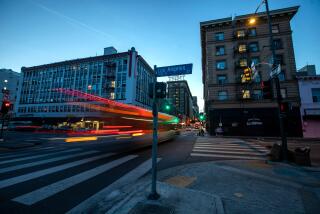COLUMN ONE : London’s Lawless Underside : The city’s Stonebridge Estates housing complex has gone from Utopian dream to crime-ridden nightmare. It is symbolic of growing unrest in Britain’s urban areas.
- Share via
LONDON — Business was booming the other day at Rocky’s, a greasy street-corner sandwich shop in the heart of one of London’s worst ghettos. But few customers were there for the chicken and fries that Abdul the proprietor offered at his caged luncheon counter.
Most had come for the drugs. Marijuana and hashish, mostly, sold in small quantities by the dozen or so young men who spend their days in and around Rocky’s. For larger quantities of crack cocaine, there were other men, in track suits and carrying radio-telephones linked to bigger dealers deep within the housing project that the London newspapers have dubbed “The Fortress of Crime.”
And it was here that A. J., Broadneck, Grasshopper, Peddler and the other young residents of Stonebridge Estates readily explained to a reporter how and why in late June they attacked a police patrol that was attempting to arrest a drug suspect outside Rocky’s.
“We only threw two bottles at them,” the man who called himself A. J. said of the incident, which left one police officer partially blind and two others with minor injuries. “What else could we do? They were strangling Nasher. They had him by the throat like this. They were killing him. You just can’t go around strangling people like that.”
A. J.’s friend Broadneck, showing a gold front tooth, a hoop earring and a burly frame that justified his nickname, interrupted angrily: “I don’t even know what they want. If they want us to help them with information on drugs and all, let ‘em come in and ask us proper. Don’t try to beat it out of us. If they keep this up, it will be like New York or Washington here in no time.”
For some Londoners, it already is.
Although tame by comparison to drug and crime wars raging on the streets of many American cities, the conversational vignette outside the housing project that authorities consider London’s most lawless spoke volumes about the unrest that lies just beneath the surface in this city, better known for its charm and grace than for crime and brutality.
Recent statistics issued by Scotland Yard show the greatest increase in urban crime since record-keeping began in Britain in the mid-1800s--more than 1 million crimes in the first three months of this year, representing a 15% increase over the same period last year.
Criminologists said most of them were crimes of the unemployed and impoverished, crimes rooted in projects such as Stonebridge Estates.
In the hands of Britain’s political opposition, the figures are an added weapon against Prime Minister Margaret Thatcher and her decade of privatization, a policy the critics say has tripled unemployment, ignored the poor and ignited the crime wave.
Social workers and community leaders in London’s poorer neighborhoods charge that such policies have also helped deepen racial tension between the overwhelmingly white British police and places such as Stonebridge, which are predominantly black--Afro-Caribbean.
“The government’s policy has led to increased unemployment, and the black people become the group that miss out the most,” said the Rev. Roy Smith, a white Anglican priest who has worked with many of the more than 8,000 Stonebridge residents during his seven years at nearby St. Michael’s Church.
“The blacks are doubly deprived because racism exists in our society. It’s not that the government is racist, but it’s a government that has no sympathy for the blacks’ cause.”
Smith and others who have worked closely with the black community said the problems at Stonebridge are not very different from those plaguing dozens of similar projects that were built several decades ago throughout Britain. But Smith conceded that the sprawling complex of high-rise tenements and rows of townhouses is an apt example of the tension behind the rising crime and growing unrest.
Externally today, the mile-square Stonebridge complex in some ways resembles a decaying prison compound. Inside, the hallways stink of urine and are covered with graffiti. Many of the tiny apartments, where several families live in 6-by-10-foot cubicles, were scorched by fire long ago but were never repaired. And the once-green courtyards, joined by walkways to the half a dozen main apartment blocks and the central commercial center, are now overgrown and strewn with uncollected garbage.
Although police said the complex is a major haven for criminals who travel out of the project to commit offenses ranging from car theft to murder (the Rev. Smith said he sees no fewer than 50 convicts from Stonebridge each week in his prison visits), authorities concede that the overwhelming majority of Stonebridge’s thousands of residents are law-abiding citizens. And they say that the crime rate inside the complex itself actually is going down.
Smith and the people of Stonebridge resent such newspaper headlines as “Daylight Ambush at Fortress Stonebridge” and “Howling Mob Attack Police.” One newspaper account said: “The Metropolitan Police describe (Stonebridge) as the most lawless and dangerous manor in the city. . . . Today’s arena is Stonebridge.”
As the police reported it, the attack on the police outside Rocky’s in the heart of the project’s shopping complex would have justified such language. The police said three officers were attacked by a mob of 50 youths while making a drug arrest during a routine patrol of the complex.
“This was something the officers stumbled onto during their regular patrols,” said Supt. Bill Ganley, whose Northwest London district of Harlesden includes Stonebridge. “They did call for assistance, but the injuries were inflicted within a minute, and it took three or four minutes for the assistance to arrive.”
But Smith and others in Stonebridge who said they witnessed the incident disputed the official version. They said the youths threw bottles at the police only after an officer began beating the suspect, a charge that Ganley denied.
Not mentioned in the official report is the government’s neglect of housing complexes such as Stonebridge and the failure of the system to keep up with the changing realities of a city as huge and diverse as London.
One of Stonebridge’s most important flaws is in its basic design, a 20-year-old architectural vision gone bad, according to Ganley and others.
“In the ‘60s, they did it this way because, first of all, what was there at the time were back-to-back Victorian houses that had become a slum,” Ganley said. “They were intent to build something fit to live in, and it was utility building. They wanted to go up rather than out.”
The designers also wanted to create a totally planned communal environment--a city within a city, with apartment blocks linked to schools, shops and private parks through intricate walkways, tunnels, sidewalks and passageways.
“They thought it was good, but it was disastrous,” Ganley said. “Today, these are environmental disaster areas.”
They are also a police officer’s nightmare, he said. “With all these walkways and tunnels, it’s almost impossible to pursue a suspect into Stonebridge.”
Left with few options, local officials in the Borough of Brent, which oversees the project, are considering razing the entire project and starting over with precisely what used to occupy the site, single homes with gardens and lanes than can be patrolled.
Already the government is spending the equivalent of millions of dollars tearing down several of the concrete walkways that link the buildings into a network of impenetrable hide-outs. This demolition program has not been popular with law-abiding residents, who are opposed to razing the place.
Few residents complain about the crime or the complex’s design. Rather, they complain about shattered windows, failed heating systems and broken elevators that have gone unrepaired for months or years.
Still, Ganley said he endorses both the walkway-removal program and eventual demolition of the project. Noting that his efforts have reduced the incidence of robberies and muggings in the three years he has served as superintendent, Ganley said the police are now working with borough architects to design a new, low-crime environment.
But even Ganley conceded that urban renewal is not the ultimate solution.
“It is a battle for hearts and minds,” he said. “The bad design of the estate is only a part of what’s working against us. Of course, crime won’t disappear along with the buildings, because the same people will be living there. And in the end, it’s people who make crime.”
On that point, even A. J. and Broadneck agreed. For them, and for all the young men of Stonebridge who agreed to talk to a reporter provided that only their nicknames are used, much of the problem is racial--the fact that virtually all the officers who police them are white, while about 80% of the area’s residents are black.
“Inside the estate,” Broadneck said, “we never even heard of racism. Whites go to blacks’ houses all the time. White kids and black kids are best friends. But when they come to nick (arrest) us, they do it hard because we’re black. We know it, and they know it. If you’re going to nick someone, fine. But nick him properly. Don’t go beating and strangling him like they do.”
Although Ganley agreed that the racial divide has left his men and the blacks of Stonebridge culturally alienated from one another, he denied that it has led to beatings. He did, however, concede that tension is high on both sides. Better education, both inside and outside Stonebridge, is needed if urban England is to avert the open combat familiar to America, he said.
There are ample signs of the anger and the brewing violence in the troubled hallways of Stonebridge. Among the endless scrawl of multicolored graffiti on almost every wall now is this:
Badder than Bad
Madder than Mad
Ruffer than Ruff
Tuffer than Tuff
More to Read
Sign up for Essential California
The most important California stories and recommendations in your inbox every morning.
You may occasionally receive promotional content from the Los Angeles Times.













